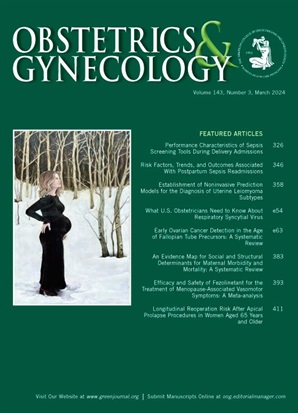Allostatic Load Mediates Associations Between Race and Ethnicity and Hypertensive Disorders of Pregnancy.
IF 4.7
2区 医学
Q1 OBSTETRICS & GYNECOLOGY
引用次数: 0
Abstract
OBJECTIVE To evaluate whether chronic stress exposure, measured by allostatic load (a biological measure of chronic stress embodiment, including stressors exacerbated by structural inequities [eg, structural racism]) and patient-reported perceived stress in the first trimester of pregnancy, mediates the association between self-identified race and ethnicity and hypertensive disorders of pregnancy (HDP). METHODS This was a secondary analysis of data from nuMoM2b (Nulliparous Pregnancy Outcomes Study: Monitoring Mothers-to-Be), a large prospective cohort study. We evaluated self-identified race and ethnicity as an independent variable (non-Hispanic Black, Hispanic, Asian, non-Hispanic White), and our outcome of interest was HDP (ie, gestational hypertension, preeclampsia or eclampsia). Allostatic load was operationalized with regression- and count-based approaches. Perceived stress was collected with the Cohen perceived stress scale. We investigated allostatic load and perceived stress and used causal mediation analyses with a counterfactual approach to evaluate whether they mediated the association between self-identified race and ethnicity and HDP, adjusting for age and tobacco use. Mediation analyses were conducted for each minoritized racial and ethnic group compared with non-Hispanic White participants. RESULTS The sample included 645 participants who developed HDP and 2,438 participants without HDP or other adverse pregnancy outcome. Allostatic load and perceived stress varied by race and ethnicity; HDP varied by allostatic load but not perceived stress. Allostatic load was a partial mediator exclusively in the comparison of non-Hispanic Black and non-Hispanic White participants (0.027, 95% CI, 0.013-0.040, P<.001; 28.9%). Perceived stress was not a significant mediator. CONCLUSION First-trimester allostatic load mediated the association between self-identified race and ethnicity and HDP for non-Hispanic Black and non-Hispanic White participants. This mediation effect was not observed in other racial and ethnic comparisons. These results demonstrate a physiologic pathway through which racism may contribute to adverse pregnancy outcomes and suggest that interventions targeting allostatic load reduction could help address racial and ethnic disparities in HDP.适应负荷介导种族和民族与妊娠高血压疾病之间的关联。
目的评估慢性应激暴露(一种慢性应激体现的生物学测量,包括由结构性不平等加剧的应激源[例如,结构性种族主义])和患者在妊娠前三个月报告的感知应激)是否介导自我认同的种族和民族与妊娠高血压疾病(HDP)之间的关联。方法:这是对nuMoM2b(未分娩妊娠结局研究:监测准妈妈)数据的二次分析,这是一项大型前瞻性队列研究。我们将自我认同的种族和民族作为一个独立变量(非西班牙裔黑人、西班牙裔、亚洲人、非西班牙裔白人)进行评估,我们感兴趣的结果是HDP(即妊娠高血压、先兆子痫或子痫)。采用基于回归和计数的方法对适应负荷进行操作。感知压力采用Cohen感知压力量表收集。我们调查了适应负荷和感知压力,并采用反事实方法进行因果中介分析,以评估它们是否介导了自我认同的种族和民族与HDP之间的关联,调整了年龄和烟草使用。与非西班牙裔白人参与者相比,对每个少数种族和族裔群体进行了调解分析。结果样本包括645名发生HDP的参与者和2438名没有HDP或其他不良妊娠结局的参与者。适应负荷和感知压力因种族和民族而异;HDP随适应负荷而变化,但不受感知应力的影响。在非西班牙裔黑人和非西班牙裔白人参与者的比较中,适应负荷是唯一的部分中介(0.027,95% CI, 0.013-0.040, P< 0.001; 28.9%)。感知压力不是一个显著的中介。结论妊娠早期适应负荷介导了非西班牙裔黑人和非西班牙裔白人受试者自我认同的种族和民族与HDP之间的关联。在其他种族和民族的比较中没有观察到这种中介效应。这些结果证明了种族主义可能导致不良妊娠结果的生理途径,并表明针对适应负荷减少的干预措施可以帮助解决HDP中的种族和民族差异。
本文章由计算机程序翻译,如有差异,请以英文原文为准。
求助全文
约1分钟内获得全文
求助全文
来源期刊

Obstetrics and gynecology
医学-妇产科学
CiteScore
11.10
自引率
4.20%
发文量
867
审稿时长
1 months
期刊介绍:
"Obstetrics & Gynecology," affectionately known as "The Green Journal," is the official publication of the American College of Obstetricians and Gynecologists (ACOG). Since its inception in 1953, the journal has been dedicated to advancing the clinical practice of obstetrics and gynecology, as well as related fields. The journal's mission is to promote excellence in these areas by publishing a diverse range of articles that cover translational and clinical topics.
"Obstetrics & Gynecology" provides a platform for the dissemination of evidence-based research, clinical guidelines, and expert opinions that are essential for the continuous improvement of women's health care. The journal's content is designed to inform and educate obstetricians, gynecologists, and other healthcare professionals, ensuring that they stay abreast of the latest developments and best practices in their field.
 求助内容:
求助内容: 应助结果提醒方式:
应助结果提醒方式:


